Optimized O3/Fe(II) Using Response Surface Methodology for Organic Phosphorus Removal in Tetrakis(hydroxymethyl)phosphonium Sulfate Wastewater
Abstract
:1. Introduction
2. Materials and Methods
2.1. Reagents
2.2. Apparatus
2.3. Preparation of the Ozone-Saturated Water
2.4. Single Factor Experiments
2.5. Response Surface Experiments
2.6. Analysis Methods
3. Results and Discussion
3.1. Single-Factor Experiments
3.1.1. Effect of Initial pH
3.1.2. Effect of the Reaction Time
3.1.3. Effect of Ozone Concentration
3.1.4. Effect of Fe(II) Dosage
3.1.5. Changes in Phosphorus Form during the Reaction
3.2. Response Surface Experiments
3.2.1. Design of the Test Scheme
3.2.2. Establishment and Fitting Analysis of the Regression Model
3.2.3. Response Surface Analysis
3.2.4. Optimization and Validation Experiments
4. Conclusions
- (1)
- Ozone oxidation could only convert most of the organic phosphorus in the THPS wastewater into inorganic phosphorus, and it could not remove phosphorus from the water. However, O3/Fe(II) could remove orthophosphate after oxidation via precipitation.
- (2)
- The single factor experiment results showed that the optimal experimental conditions of O3/Fe(II) removal of organic phosphorus in the THPS wastewater were: initial pH of 3, reaction time of 60 min, and Fe(II) dosage of 20 mg/L. Due to the limitations of the laboratory conditions, 14 mg/L was the maximum and best ozone concentration conditions. The optimal value of ozone concentration needs to be founded in further research.
- (3)
- The response surface experiment results showed that the model had good regression, and the lack of fit was not significant. The initial pH and ozone concentration had significant effects on the removal of organic phosphorus.
- (4)
- The optimal reaction conditions predicted by the response surface model were: pH of 3.10, reaction time of 74.77 min, Fe(II) dosage of 19.77 mg/L, and ozone concentration of 14 mg/L. The removal rate of organic phosphorus in the verification experiment was 86.04%, and the experimental value fit well with the simulation value, with a deviation of 0.91%.
Author Contributions
Funding
Data Availability Statement
Conflicts of Interest
References
- Okoro, C.C. The Biocidal Efficacy of Tetrakis–hydroxymethyl Phosphonium Sulfate (THPS) Based Biocides on Oil Pipeline PigRuns Liquid Biofilms. Pet. Sci. Technol. 2015, 33, 1366–1372. [Google Scholar] [CrossRef]
- Xiao, B.; Li, H.; Yan, H.; Guo, X. Evaluation of the sludge reduction effectiveness of a metabolic uncoupler–tetrakis (hydroxymethyl) phosphonium sulfate in anaerobic/anoxic/oxic process. Desalin. Water Treat. 2016, 57, 5772–5780. [Google Scholar] [CrossRef]
- Fathima, N.N.; Chandrabose, M.; Aravindhan, R.; Rao, J.R.; Nair, B.U. Iron phosphonium combination tanning: Towards a win–win approach. J. Am. Leather Chem. Assoc. 2005, 100, 273–281. [Google Scholar]
- Liu, F.Y.; Hong, M.Z.; Liu, D.M.; Li, Y.W.; Shou, P.S.; Yan, H.; Shi, G.Q. Biodegradation of methyl parathion by Acinetobacter radioresistens USTB-04. J. Environ. Sci. 2007, 19, 1257–1260. [Google Scholar] [CrossRef]
- Zhao, J.W.; Yuan, Q.J.; Sun, Y.J.; Zhang, J.; Zhang, D.L.; Bian, R.X. Effect of fluoxetine on enhanced biological phosphorus removal using a sequencing batch reactor. Bioresour. Technol. 2021, 320, 124396. [Google Scholar] [CrossRef]
- Okoro, C.C.; Samuel, O.; Lin, J. The effects of Tetrakis-hydroxymethyl phosphonium sulfate (THPS), nitrite and sodium chloride on methanogenesis and corrosion rates by methanogen populations of corroded pipelines. Corros. Sci. 2006, 112, 507–516. [Google Scholar] [CrossRef]
- Moiseev, D.V.; James, B.R. Tetrakis(hydroxymethyl)phosphonium salts: Their properties, hazards and toxicities. Phosphorus Sulfur Silicon Relat. Elem. 2019, 195, 263–279. [Google Scholar] [CrossRef]
- Sillanpaa, M.; Ncibi, M.C.; Matilainen, A. Advanced oxidation processes for the removal of natural organic matter from drinking water sources: A comprehensive review. J. Environ. Manag. 2018, 208, 56–76. [Google Scholar] [CrossRef]
- Wang, J.; Xu, L. Advanced Oxidation Processes for Wastewater Treatment: Formation of Hydroxyl Radical and Application. Crit. Rev. Environ. Sci. Technol. 2012, 42, 251–325. [Google Scholar] [CrossRef]
- Wang, J.; Chen, H. Catalytic ozonation for water and wastewater treatment: Recent advances and perspective. Sci. Total Environ. 2020, 704, 135249. [Google Scholar] [CrossRef]
- Ma, D.; Yi, H.; Lai, C.; Liu, X.; Huo, X.; An, Z.; Li, L.; Fu, Y.; Li, B.; Zhang, M.; et al. Critical review of advanced oxidation processes in organic wastewater treatment. Chemosphere 2021, 275, 130104. [Google Scholar] [CrossRef] [PubMed]
- Malik, S.N.; Ghosh, P.C.; Vaidya, A.N.; Mudliar, S.N. Hybrid ozonation process for industrial wastewater treatment: Principles and applications: A review. J. Water Process. Eng. 2020, 35, 101193. [Google Scholar] [CrossRef]
- Yang, L.; Sheng, M.; Li, Y.; Xue, W.; Li, K.; Cao, G. A hybrid process of Fe-based catalytic ozonation and biodegradation for the treatment of industrial wastewater reverse osmosis concentrate. Chemosphere 2020, 138, 124639. [Google Scholar] [CrossRef] [PubMed]
- Zeng, Z.; Zou, H.; Xin, L.; Sun, B.; Chen, J.; Shao, L. Ozonation of Phenol with O3/Fe(II) in Acidic Environment in a Rotating Packed Bed. Ind. Eng. Chem. Res. 2012, 51, 10509–10516. [Google Scholar] [CrossRef]
- Zeng, Z.; Zou, H.; Xin, L.; Sun, B.; Chen, J.; Shao, L. Ozonation of acidic phenol wastewater with O3/Fe(II) in a rotating packed bed reactor: Optimization by response surface methodology. Chem. Eng. Process. 2012, 60, 1–8. [Google Scholar] [CrossRef]
- Yu, D.; Wu, M.; Hu, Q.; Wang, L.; Lv, C.; Zhang, L. Iron–based metal–organic frameworks as novel platforms for catalytic ozonation of organic pollutant: Efficiency and mechanism. J. Hazard. Mater. 2019, 367, 456–464. [Google Scholar] [CrossRef]
- Yu, D.; Wang, L.; Yang, T.; Yang, G.; Wang, D.; Ni, D.; Wu, M. Tuning Lewis acidity of iron–based metal–organic frameworks for enhanced catalytic ozonation. Chem. Eng. J. 2021, 404, 0127075. [Google Scholar] [CrossRef]
- Nawrocki, J.; Kasprzyk–Hordern, B. The efficiency and mechanisms of catalytic ozonation. Appl. Catal. B Environ. 2010, 99, 27–42. [Google Scholar] [CrossRef]
- Wu, C.; Kuo, C.; Chang, C. Homogeneous catalytic ozonation of CI Reactive Red 2 by metallic ions in a bubble column reactor. J. Hazard. Mater. 2008, 154, 748–755. [Google Scholar] [CrossRef]
- Nidheesh, P.V. Heterogeneous Fenton catalysts for the abatement of organic pollutants from aqueous solution: A review. RSC Adv. 2015, 5, 40552–40577. [Google Scholar] [CrossRef]
- Box, G.; Wilson, K. On the experimental attainment of optimum conditions. J. R. Stat. Soc. Ser. B Stat. Methodol. 1951, 13, 1–38. [Google Scholar] [CrossRef]
- Candioti, L.V.; De Zan, M.M.; Camara, M.S.; Goicoechea, H.C. Experimental design and multiple response optimization. Using the desirability function in analytical methods development. Talanta 2014, 124, 123–138. [Google Scholar] [CrossRef] [PubMed]
- Zhou, Z.; Li, D.; Xiao, T.; Cao, Z.; Du, W. Response surface guided adaptive slope reliability analysis in spatially varying soils. Comput. Geotech. 2021, 132, 103966. [Google Scholar] [CrossRef]
- Witek–Krowiak, A.; Chojnacka, K.; Podstawczyk, D.; Dawiec, A.; Pokomeda, K. Application of response surface methodology and artificial neural network methods in modelling and optimization of biosorption process. Bioresour. Technol. 2014, 160, 150–160. [Google Scholar] [CrossRef]
- Danmaliki, G.I.; Saleh, T.A.; Shamsuddeen, A.A. Response surface methodology optimization of adsorptive desulfurization on nickel/activated carbon. Chem. Eng. J. 2017, 313, 993–1003. [Google Scholar] [CrossRef]
- Ruqayyah, T.I.D.; Jamal, P.; Alam, M.Z.; Mirghani, M.E.S.; Jaswir, I.; Ramli, N. Application of response surface methodology for protein enrichment of cassava peel as animal feed by the white–rot fungus Panus tigrinus M609RQY. Food Hydrocoll. 2014, 42, 298–303. [Google Scholar] [CrossRef]
- Bader, H.; Hoigne, J. Determination of ozone in water by the indigo method. Water Res. 1981, 15, 449–456. [Google Scholar] [CrossRef]
- Wei, C.; Ma, C. Quantitative prediction of direct and indirect dye ozonation kinetics. Water Res. 2000, 34, 3153–3160. [Google Scholar]
- Sumegová, L. Degradation of Benzothiazole by Ozonation and Adsorptive Ozonation. Chem. Biochem. Eng. Q. 2015, 29, 63–66. [Google Scholar] [CrossRef]
- Chen, Y.; Hsu, Y.; Lin, C.; Tai, C.; Liu, H. Volatile organic compounds absorption in a cross–flow rotating packed bed. Environ. Sci. Technol. 2008, 42, 2631–2636. [Google Scholar] [CrossRef]
- Piera, E.; Calpe, J.C.; Brillas, E.; Domenech, X.; Peral, J. 2,4–Dichlorophenoxyacetic acid degradation by catalyzed ozonation: TiO2/UVA/O–3 and Fe(II)/UVA/O–3 systems. Appl. Catal. B Environ. 2000, 27, 169–177. [Google Scholar] [CrossRef]
- Li, X.; Chen, W.; Ma, L.; Huang, Y.; Wang, H. Characteristics and mechanisms of catalytic ozonation with Fe–shaving–based catalyst in industrial wastewater advanced treatment. J. Clean Prod. 2019, 222, 174–181. [Google Scholar] [CrossRef]
- Beltran, F.J.; Rivas, F.J.; Montero-de-Espinosa, R. Iron type catalysts for the ozonation of oxalic acid in water. Water Res. 2005, 39, 3553–3564. [Google Scholar] [CrossRef] [PubMed]
- Gadekar, M.R.; Ahammed, M.M. Modelling dye removal by adsorption onto water treatment residuals using combined response surface methodology-artificial neural network approach. J. Environ. Manag. 2019, 231, 241–248. [Google Scholar] [CrossRef]
- Mohammad, A.T.; Abdulhameed, A.S.; Jawad, A.H. Box-Behnken design to optimize the synthesis of new crosslinked chitosan-glyoxal/TiO2 nanocomposite: Methyl orange adsorption and mechanism studies. Int. J. Biol. Macromol. 2019, 129, 98–109. [Google Scholar] [CrossRef] [PubMed]
- Chaturvedi, S.; Dave, P.N. Removal of iron for safe drinking water. Desalination 2012, 303, 1–11. [Google Scholar] [CrossRef]
- Xu, X.Y.; Cheng, Y.; Zhang, T.T.; Ji, F.Y.; Xu, X. Treatment of pharmaceutical wastewater using interior micro-electrolysis/Fenton oxidation-coagulation and biological degradation. Chemosphere 2016, 152, 23–30. [Google Scholar] [CrossRef]
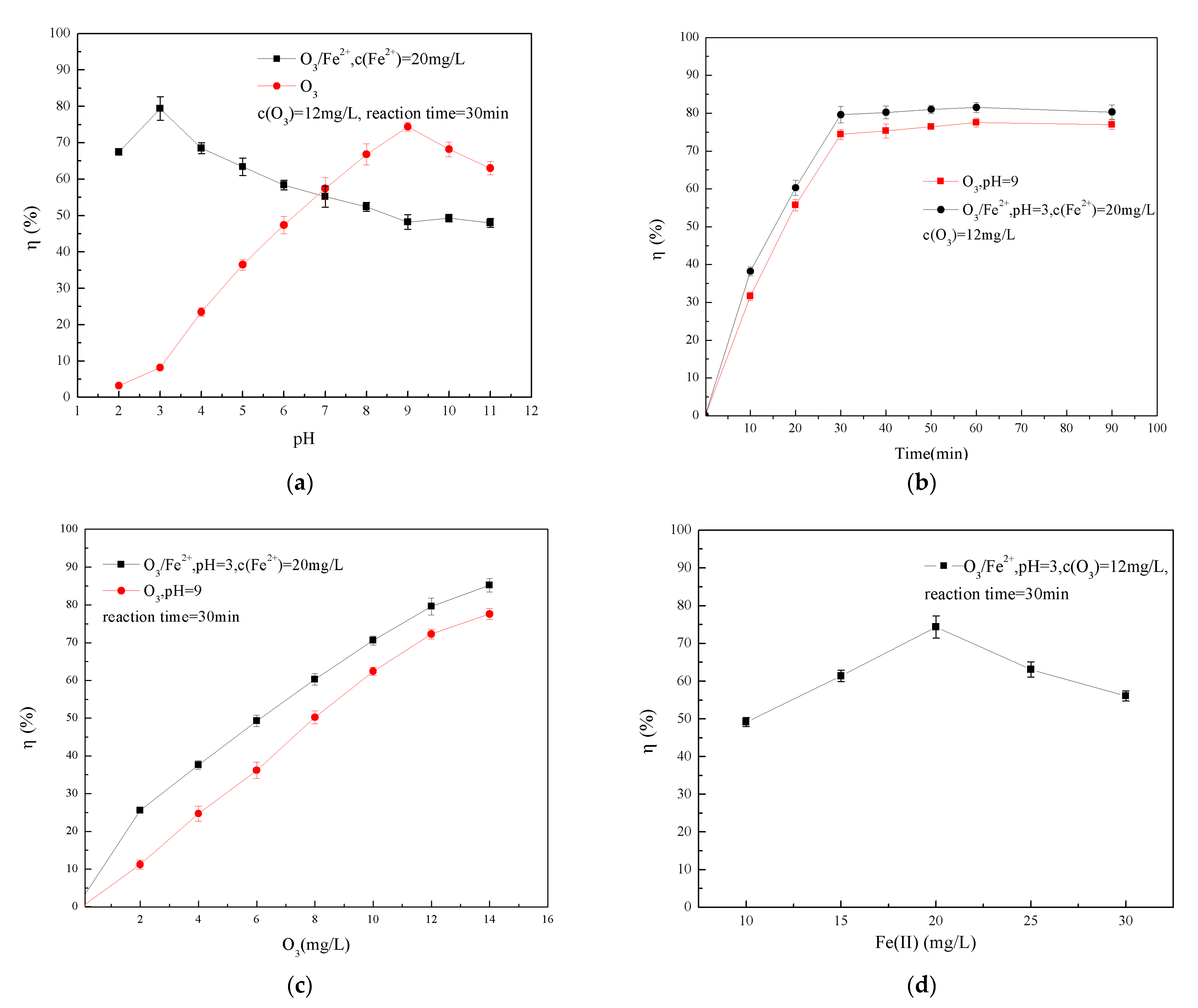

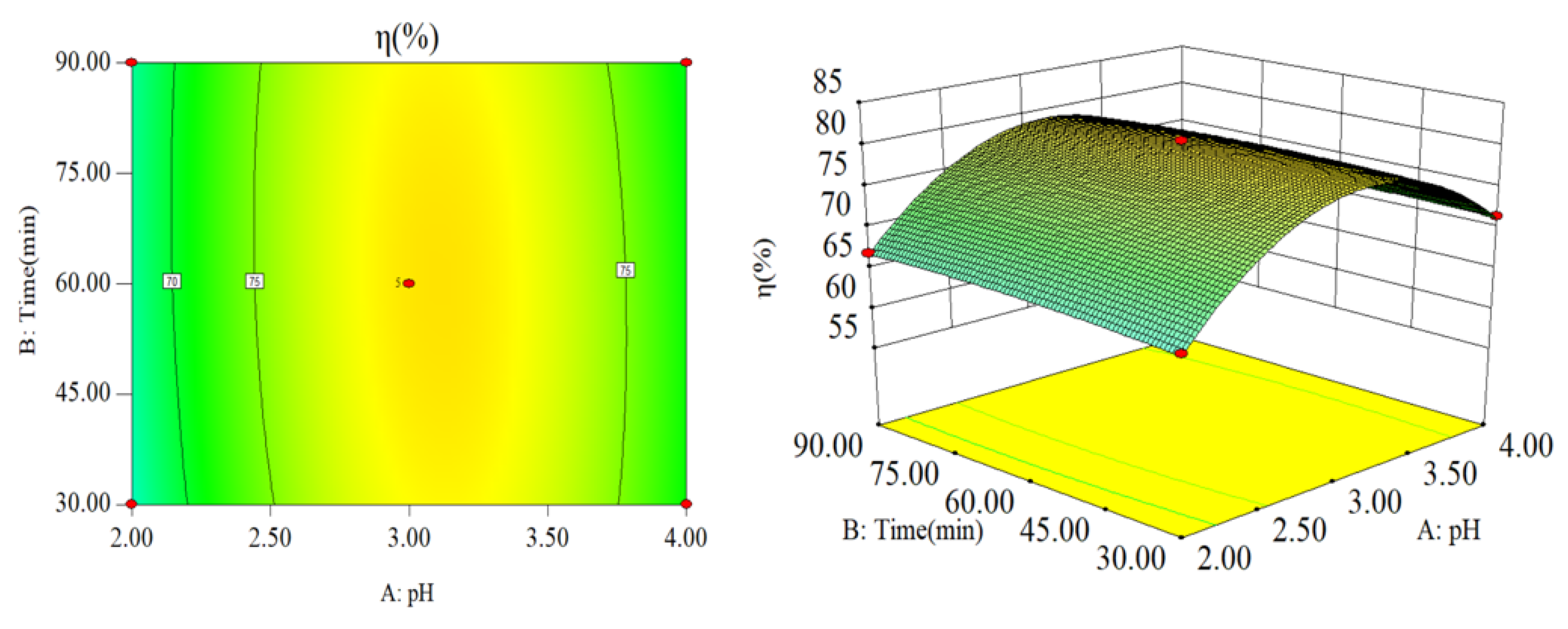

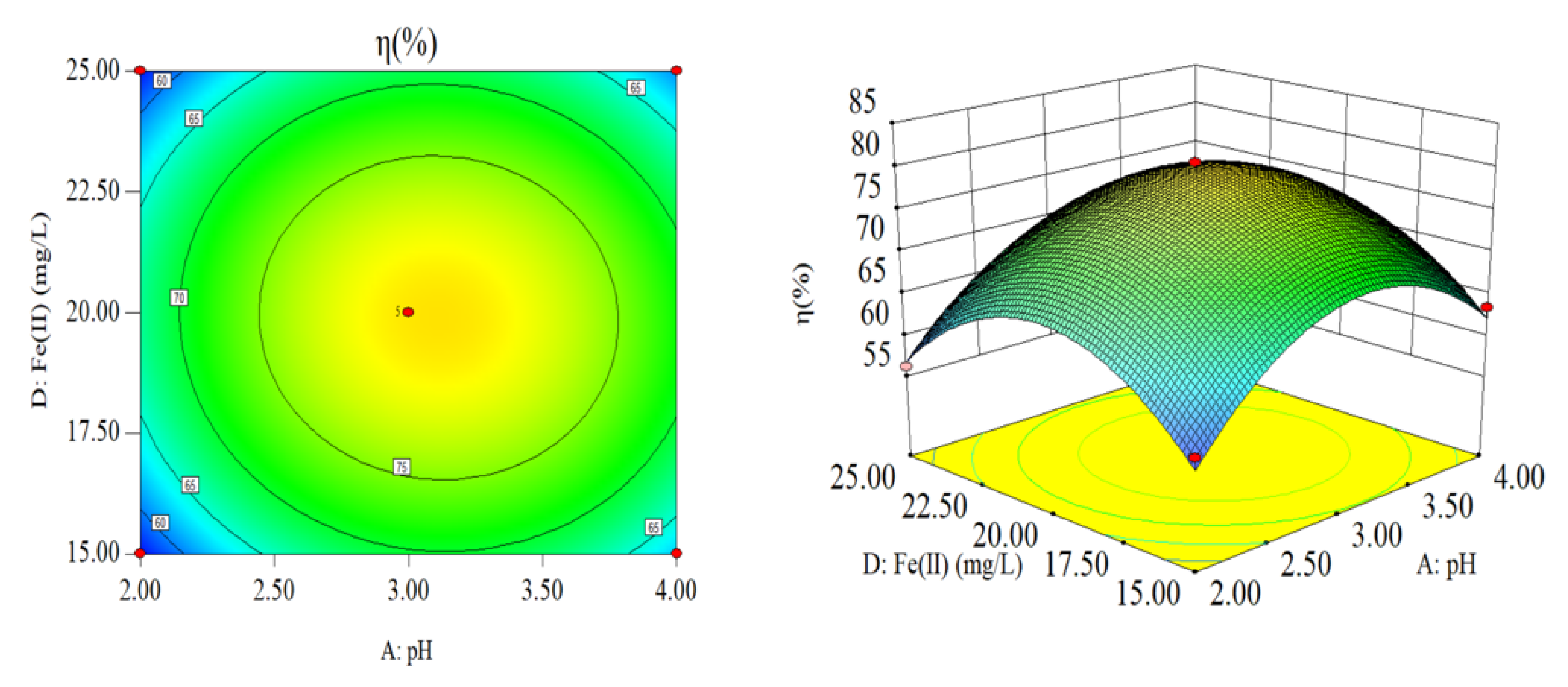
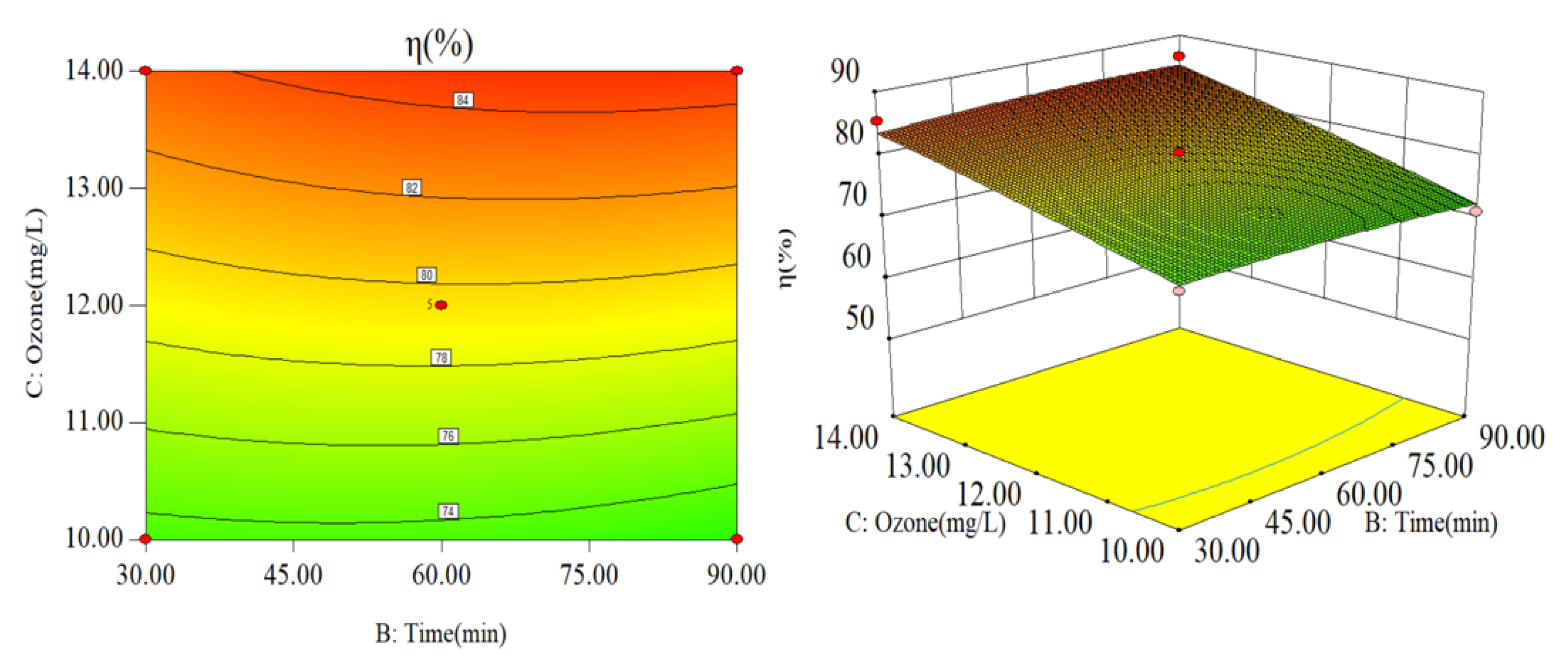

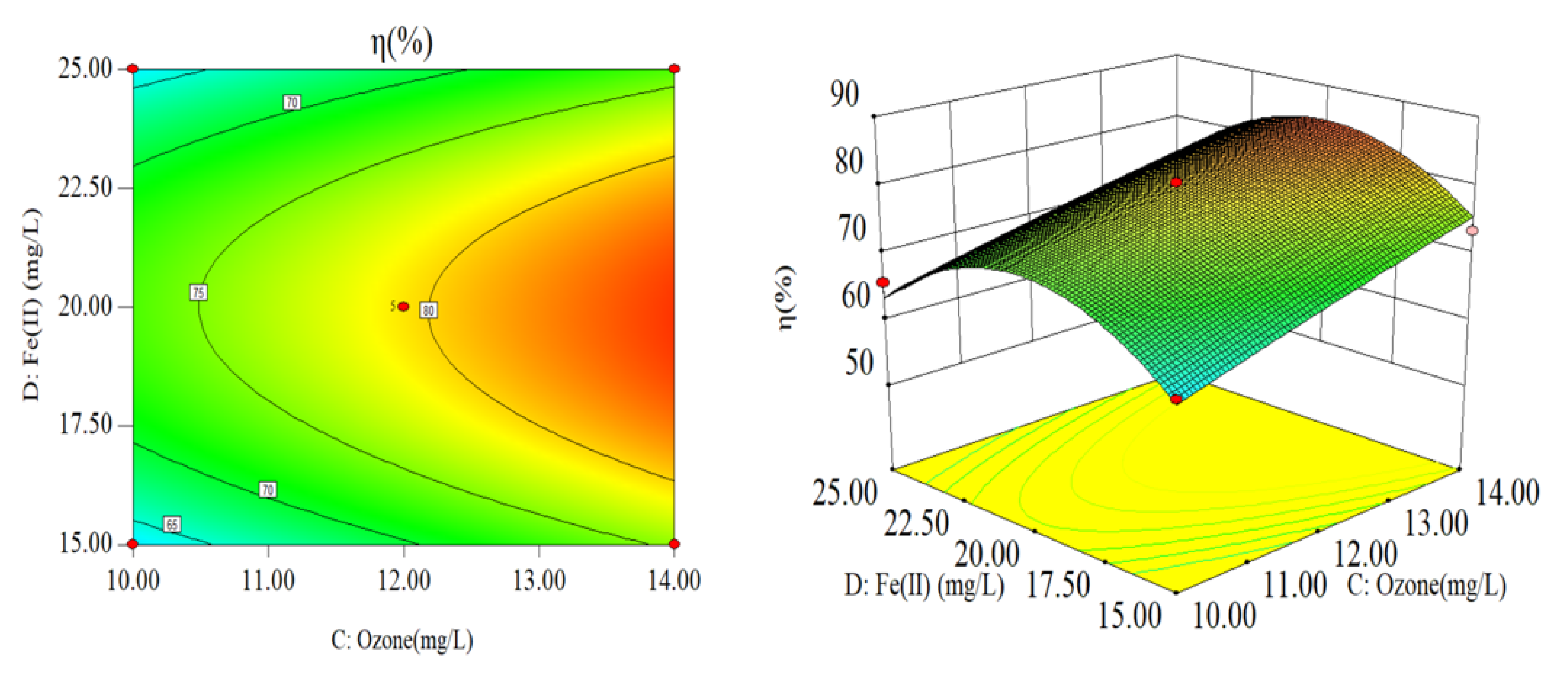
| Level | Factor A pH | Factor B Reaction Time (min) | Factor C Ozone Concentration (mg/L) | Factor D Fe(II) Dosage (mg/L) |
|---|---|---|---|---|
| −1 | 2 | 30 | 10 | 15 |
| 0 | 3 | 60 | 12 | 20 |
| 1 | 4 | 90 | 14 | 25 |
| Run No. | pH | Reaction Time (min) | Ozone Concentration (mg/L) | Fe(II) Dosage (mg/L) | η (%) |
|---|---|---|---|---|---|
| 1 | 3 | 90 | 10 | 20 | 71.1 |
| 2 | 4 | 60 | 14 | 20 | 76.3 |
| 3 | 4 | 60 | 12 | 25 | 59.7 |
| 4 | 3 | 60 | 12 | 20 | 79.1 |
| 5 | 3 | 90 | 14 | 20 | 86.3 |
| 6 | 4 | 60 | 12 | 15 | 63.4 |
| 7 | 3 | 60 | 14 | 15 | 73.5 |
| 8 | 3 | 30 | 12 | 25 | 67.1 |
| 9 | 3 | 60 | 14 | 25 | 73.1 |
| 10 | 3 | 60 | 12 | 20 | 78.4 |
| 11 | 3 | 90 | 12 | 15 | 68.5 |
| 12 | 4 | 90 | 12 | 20 | 70.5 |
| 13 | 2 | 90 | 12 | 20 | 66.9 |
| 14 | 2 | 60 | 12 | 25 | 56.2 |
| 15 | 2 | 60 | 12 | 15 | 57.8 |
| 16 | 4 | 60 | 10 | 20 | 65.1 |
| 17 | 3 | 30 | 12 | 15 | 68.2 |
| 18 | 2 | 60 | 14 | 20 | 71.5 |
| 19 | 2 | 30 | 12 | 20 | 66.1 |
| 20 | 3 | 60 | 10 | 15 | 63.7 |
| 21 | 2 | 60 | 10 | 20 | 60.3 |
| 22 | 3 | 60 | 12 | 20 | 78.9 |
| 23 | 3 | 30 | 10 | 20 | 72.5 |
| 24 | 3 | 30 | 14 | 20 | 85.5 |
| 25 | 3 | 60 | 10 | 25 | 65.8 |
| 26 | 3 | 60 | 12 | 20 | 80.5 |
| 27 | 3 | 90 | 12 | 25 | 68.5 |
| 28 | 3 | 60 | 12 | 20 | 80.5 |
| 29 | 4 | 30 | 12 | 20 | 71.5 |
| Source | Sum of Squares | DF * | Mean Square | F Value | p-Value, Prob > F |
|---|---|---|---|---|---|
| Model | 1699.14 | 14 | 121.37 | 57.44 | <0.0001 |
| A-pH | 63.94 | 1 | 63.94 | 30.26 | <0.0001 |
| B-Time | 0.07 | 1 | 0.07 | 0.03 | 0.8607 |
| C-O3 | 381.94 | 1 | 381.94 | 180.75 | <0.0001 |
| D-Fe(II) | 1.84 | 1 | 1.84 | 0.87 | 0.3665 |
| AB | 0.81 | 1 | 0.81 | 0.38 | 0.5458 |
| AC | 0 | 1 | 0 | 0 | 1.0000 |
| AD | 1.10 | 1 | 1.10 | 0.52 | 0.4820 |
| BC | 1.21 | 1 | 1.21 | 0.57 | 0.4618 |
| BD | 0.30 | 1 | 0.30 | 0.14 | 0.7108 |
| CD | 1.56 | 1 | 1.56 | 0.74 | 0.4043 |
| A2 | 686.82 | 1 | 686.82 | 325.03 | <0.0001 |
| B2 | 2.45 | 1 | 2.45 | 1.16 | 0.2995 |
| C2 | 0.86 | 1 | 0.86 | 0.41 | 0.5328 |
| D2 | 683.48 | 1 | 683.48 | 323.45 | <0.0001 |
| Residual | 29.58 | 14 | 2.11 | ||
| Lack of fit | 25.86 | 10 | 2.59 | 2.77 | 0.1688 |
| Pure error | 3.73 | 4 | 0.93 |
| Project | Value | Project | Value |
|---|---|---|---|
| Std. Dev. | 1.45 | R-Squared | 0.9829 |
| Mean | 70.57 | Adj R-Squared | 0.9658 |
| CV/% | 2.06 | Pred R-Squared | 0.9105 |
| PRESS | 154.75 | Adeq Precision | 27.054 |
| Methods | Remove Efficiency (%) | Reaction Time | pH | Operating Condition |
|---|---|---|---|---|
| O3/Fe(II) | 80–85 | 60 min | 2.5–3.5 | Normal pressure and temperature |
| Biological method | 3 | 24–48 h | 6.5–8.0, depends on the bacteria | Normal pressure and temperature, depends on the bacteria |
| Wet oxidation | 98 | 15 min | Unlimited | 470–550 K, 4–10 MPa |
| Fenton-like | 50–60 | 1–3 h | 1–3 | Normal pressure and temperature |
Publisher’s Note: MDPI stays neutral with regard to jurisdictional claims in published maps and institutional affiliations. |
© 2022 by the authors. Licensee MDPI, Basel, Switzerland. This article is an open access article distributed under the terms and conditions of the Creative Commons Attribution (CC BY) license (https://creativecommons.org/licenses/by/4.0/).
Share and Cite
Peng, Y.; Xu, H.; Li, Y.; Zhang, Y.; Duan, D.; Ren, M. Optimized O3/Fe(II) Using Response Surface Methodology for Organic Phosphorus Removal in Tetrakis(hydroxymethyl)phosphonium Sulfate Wastewater. Sustainability 2022, 14, 6318. https://doi.org/10.3390/su14106318
Peng Y, Xu H, Li Y, Zhang Y, Duan D, Ren M. Optimized O3/Fe(II) Using Response Surface Methodology for Organic Phosphorus Removal in Tetrakis(hydroxymethyl)phosphonium Sulfate Wastewater. Sustainability. 2022; 14(10):6318. https://doi.org/10.3390/su14106318
Chicago/Turabian StylePeng, Yangbin, Hongbin Xu, Yaohua Li, Yuhuan Zhang, Dongge Duan, and Mengyue Ren. 2022. "Optimized O3/Fe(II) Using Response Surface Methodology for Organic Phosphorus Removal in Tetrakis(hydroxymethyl)phosphonium Sulfate Wastewater" Sustainability 14, no. 10: 6318. https://doi.org/10.3390/su14106318
APA StylePeng, Y., Xu, H., Li, Y., Zhang, Y., Duan, D., & Ren, M. (2022). Optimized O3/Fe(II) Using Response Surface Methodology for Organic Phosphorus Removal in Tetrakis(hydroxymethyl)phosphonium Sulfate Wastewater. Sustainability, 14(10), 6318. https://doi.org/10.3390/su14106318






